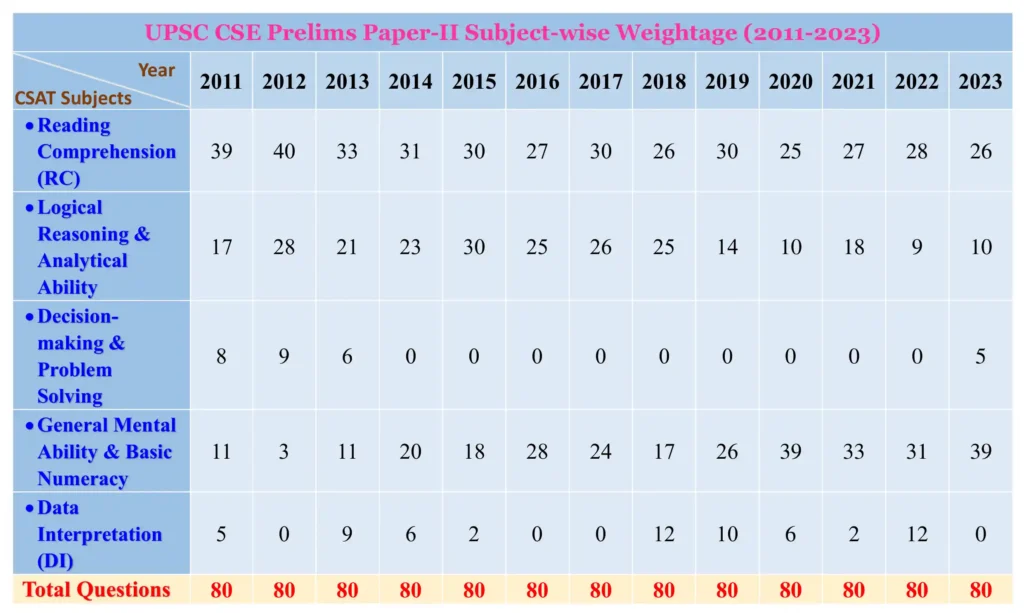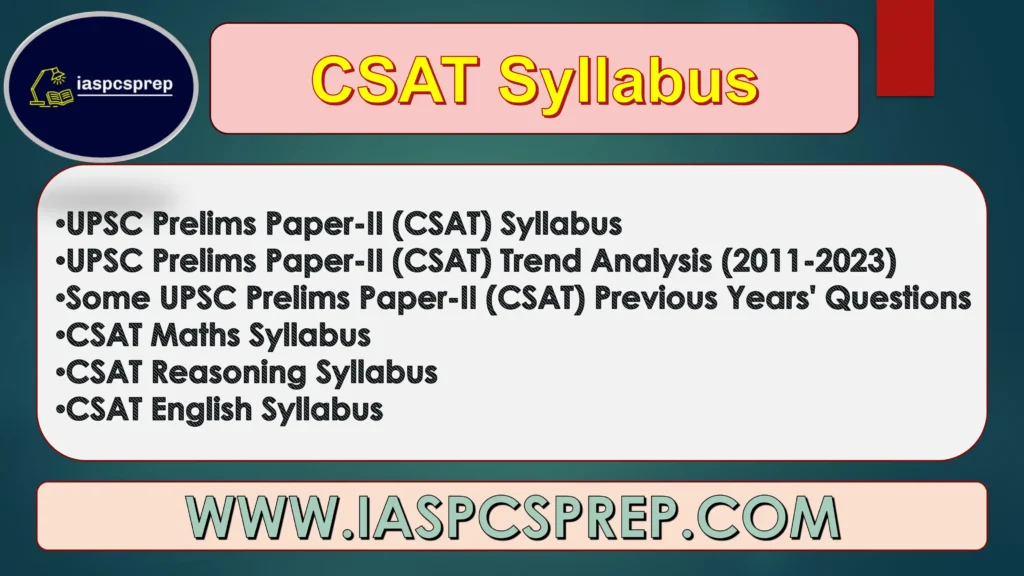| CSAT Syllabus |
The link of PDF of this CSAT Syllabus is given below the explanation, you can download the PDF by going below.
CSAT Syllabus
In this post, we will discuss about the UPSC Prelims Paper-II (CSAT) Syllabus, CSAT Trend Analysis, Some Previous Years UPSC CSAT Questions, CSAT Maths Syllabus, CSAT Reasoning Syllabus, CSAT English Syllabus etc.
UPSC Prelims Paper-II (CSAT) Syllabus:
- Comprehension;
- Interpersonal skills including communication skills;
- Logical reasoning and analytical ability;
- Decision-making and problem-solving;
- General mental ability;
- Basic numeracy (numbers and their relations, orders of magnitude, etc.) – (Class X level),
- Data interpretation (charts, graphs, tables, data sufficiency, etc. – (Class X level).
Note 1 : Paper-II of the Civil Services (Preliminary) Examination will be a qualifying paper with minimum qualifying marks fixed at 33%.
UPSC Prelims Paper-II (CSAT) Trend Analysis

Some UPSC Prelims Paper-II (CSAT) Previous Years’ Questions
Q1. If a bus travels 160km in 4 hours and a train travels 320km in 5 hours at uniform speeds, then what is the ratio of the distances travelled by them in one hour? (2011)
a) 8:5
b) 5:8
c) 4:5
d) 1:2
Q2. We started pitching the highest comp that has ever been made. Everything took five times as long as it would have taken in a place where there was enough air to breathe, but at last we got the tent up, and when we crawled in, it was not too bad. There was was only a light wind, and inside it was not too cold for us to take off their gloves. At night most climbers take off their boots; but I prefer to keep them on. Hillary, on the other hand, took his off and laid them next to his sleeping bag. (2012)
They took a long time to finish the work because
a) they were very tired.
b) there was not enough air to breathe.
c) it was very cold.
d) it was very dark.
Q3. Five people A, B, C, D and E are seated about a round table. Every chair is spaced equidistant from adjacent chairs. (2013)
(i) C is seated next to A.
(ii) A is seated two seats from D.
(iii) B is not seated next to A.
Which of the following must be true?
(I) D is seated next to B.
(II) E is seated next to A.
Select the correct answer from the codes given below:
a) I only
b) II only
c) Both I and II
d) Neither I nor II
Q4. A gardener increased the area of his rectangular garden by increasing its length by 40% and decreasing its width by 20%. (2014)
The area of the new garden
a) has increased by 20%.
b) has increased by 12%.
c) has increased by 8%.
d) is exactly the same as the old area.
Q5. Flamingos in large flecks in the wild are social and extremely loyal. They perform group mating dances. Parents are very fond of their chicks, gathering them into crèches for protection while both males and females fly off to search for food. (2015)
Which among the following is the most logically corollary to the above passage?
a) Mass nesting in all species of birds is essential to ensure complete survival of their off spring.
b) Only birds have the capacity to develop social behaviour and thus can do mass nesting to raise their chicks in safety.
c) Social behaviour in some species of birds increases the odds of survival in an unsafe world.
d) All species of birds set crèches for their chicks to up teach them social behaviour and loyalty.
Q6. A military code writes SYSTEM as SYSMET and NEARER as AENRER. Using the same code, FRACTION can be written as: (2016)
a) CARFTION
b) FRACNOIT
c) NOITCARF
d) CARFNOIT
Q7. There are thirteen 2-digit consecutive odd numbers. If 39 is the mean of the first five such numbers, then what is the mean of all the thirteen numbers? (2017)
a) 47
b) 49
c) 51
d) 45
Q8. Scientific knowledge has its dangers, but so has every great thing. Over and beyond the dangers with which it threatens the present, it opens up as nothing else can, the vision of possible happy world; a world without poverty, without war, with little illness. Science, whatever unpleasant consequences it may have by the way, is in its very nature a liberator. (2018)
Which one of the following is the most important implication of the passage?
a) A happy world is a dream of science.
b) Science only can build a happy world, but it is also the only major threat.
c) A happy world is not possible without science.
d) A happy world is not at all possible with or without science.
Q9. Consider the following Statements and Conclusions: (2019)
Statements:
1. Some rats are cats.
2. Some cats are dogs.
3. No dog is a cow.
Conclusions:
I. No cow is a cat.
II. No dog is a rat.
III. Some cats are rats.
Which of the above conclusions is/are drawn from the statements?
a) I, II and III
b) Only I and II
c) Only III
d) Only II and III
Q10. A person bought a car and sold it for ₹ 300000. If he incurred a loss of 20% Loss of 20%, then how much did he spend to buy the car? (2020)
a) ₹ 360000
b) ₹ 365000
c) ₹ 370000
d) ₹ 375000
Q11. In India, the objective of macroeconomic policy is to enhance the economic welfare of the people, and any one one wing of such macro policy, monetary or fiscal, cannot independently work without active support of another. (2021)
Which one of the following statements best reflects the corollary to the passage given above?
a) The central bank cannot work independently of the Government.
b) Government should regulate financial markets and institutions closely.
c) Market economy is not compatible with the serialist policies of the Government.
d) Financial sector reforms are required for enhancing the economic welfare of the people.
Q12. Three persons A, B and C are standing in a queue not necessarily in the same order. There are are 4 persons between A and B, and 7 persons between B and C. If there are 11 persons ahead of C and 13 behind A, what could be the minimum number of persons in the queue? (2022)
a) 22
b) 28
c) 32
d) 38
Q13. A rectangular floor measures 4m in length & 2.2m in breadth. Tiles of size 140cm by 60cm have to be laid such that the tiles do not overlap. A tile can be placed in any orientation so long as its edges are parallel to the edges of the floor. What is the maximum number of tiles that can be accommodated on the floor? (2023)
a) 6
b) 7
c) 8
d) 9
CSAT Maths Syllabus |
|
| Number System | Profit & Loss |
| Simplification | Discount |
| Divisibility Rules | Simple Interest |
| Surds and Indices | Compound Interest |
| LCM & HCF | Partnership |
| Ratio & Proportion | Time & Work |
| Percentage | Work & Wages |
| Average | Pipes and Cisterns |
| Probability | Mathematical Venn Diagram |
| Mixture & Alligations | Data Interpretation (DI) |
| Trains | Data Sufficiency |
| Boats & Streams | Mensuration |
| Speed, Time & Distance | Geometry |
| Permutation & Combination |
Miscellaneous |
CSAT Reasoning Syllabus |
|
| Coding & Decoding | Counting of Figures |
| Series | Image Formation |
| Blood Relations | Mathematical Operations |
| Direction & Distance | Alphabet Test |
| Venn Diagram | Analogy |
| Calendar | Statements & Arguments |
| Clock | Statements & Conclusions |
| Cubes and Dice | Statements & Assumptions |
| Syllogism | Course of Actions |
| Puzzle | Assertion & Reasons |
| Seating Arrangement | Cause & Effect |
| Sequence & Order | Ranking |
| Arithmetical Reasoning | Miscellaneous |
CSAT English Syllabus |
|
| Comprehension: → a) Analytical Passages → b) Descriptive Passages → c) Hypothetical Passages |
Idioms and Phrases |
| Synonyms and Antonyms | Vocabulary |
| Some Important Links | |
| Download CSAT Syllabus PDF | Click Here |
| If you are satisfied with our website iaspcsprep.com, Please like and share with more people. | |
| Follow on Instagram | Follow Now |
| Join WhatsApp Group for PDF | Join Now |
| For any Query and Feedback, Contact Us at – study@iaspcsprep.com. | |


Related Posts:


